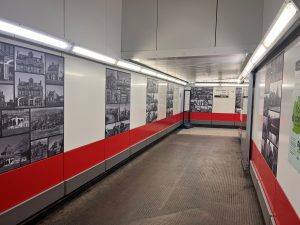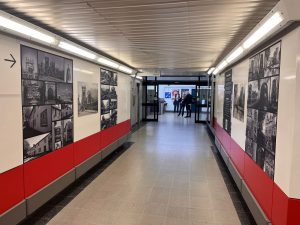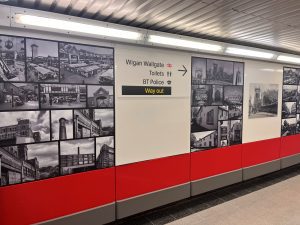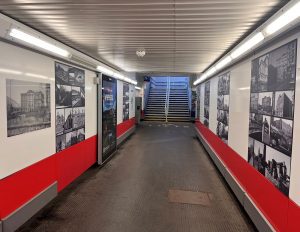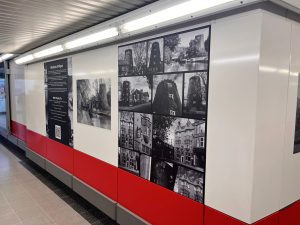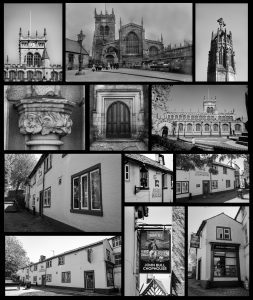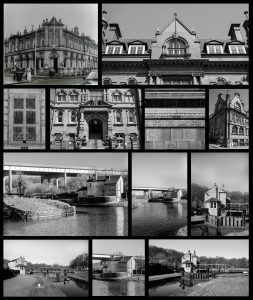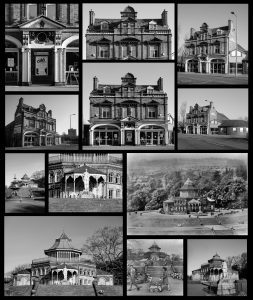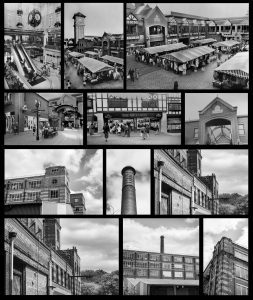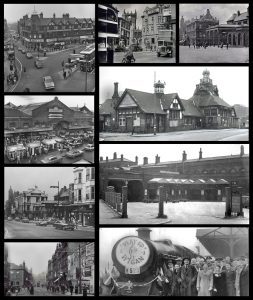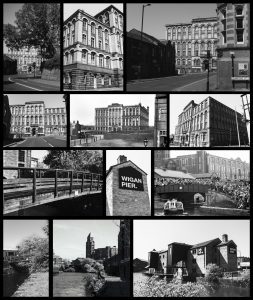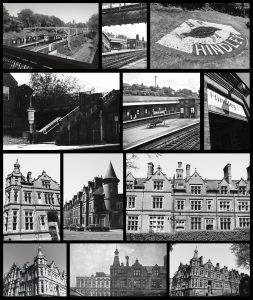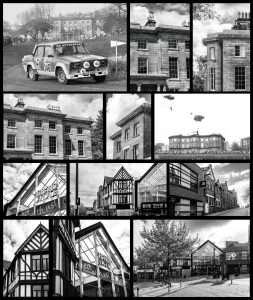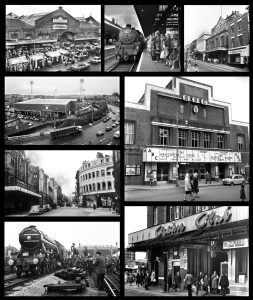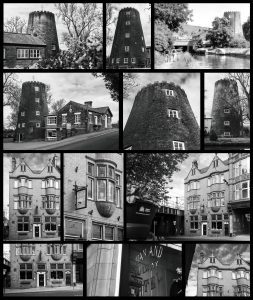
Following the success of our ‘A to Z of Wiganese’ mural, South East Lancashire Community Rail Partnership have again worked with Avanti West Coast to produce another artwork entitled ‘Wonders of Wigan’, displayed at Wigan North Western station.
Using social media, online surveys and post-boxes located in various town centre locations, we asked the local community to nominate their favourite Wigan buildings of past and present to feature in a photographic mural.
We worked with local photographers and University graduates to collect and commission a range of archive and modern images, producing black and white designs that celebrate a range of our iconic Wigan buildings.
The mural also features both Wigan North Western and Wigan Wallgate stations, and was created as part of Railway 200, marking the 200th anniversary of the birth of the modern railway!
With thanks to –
- Photographers: Gareth Morton, Viv Fletcher, Chris Fletcher, Ben Midlane, Nikola Bobowik & Bethany Castle
- Archive Images: Frank Orrell & The Wigan Observer
- Buildings History: Emily Oldfield
- Print & Installation: Signprint Solutions & Impression Ltd & Pro Vinyl Manchester
- Funded by: Avanti West Coast & Community Rail Network’
- Project Manager: Dr Steph Dermott
Click here for image Gallery
Featured Buildings:
Haigh Hall
Now a Grade II listed building, Haigh Hall was the seat of the Earls of Balcarres for many years, with the current hall built between 1827 and 1840 for James Lindsay, 7th Earl of Balcarres. The Lindsay family made much of its fortune from rich coal seams under the estate, going on to found the Wigan Coal and Iron Company.
Much of the facing of the hall is composed of hard sandstone brought specially by canal from Parbold – a fine example of local architecture. Outside, extensive tree planting took place (potentially to hide the view of the coal mines!) some of which now composes Haigh Woodland Park. During the 1860s Cotton Famine that significantly affected Lancashire, laying pathways through the plantations provided work for the local unemployed.
Inside, the hall has a fascinating library history! Bibliotheca Lindesiana, the Lindsay family’s library, became one of Britain’s largest private collections, with some manuscripts being sold to Enriqueta Rylands for the John Rylands Library in Manchester.
Wigan Council now owns the building, with exciting plans announced in 2023 to transform the hall and estate, with funding from the government’s Levelling Up Fund and the Council.
The Old Courts
Also known as Gerrard Winstanley House, this is a former Magistrates Court and Police Station first opened in 1887 and located on Crawford Street. Largely constructed from striking red brick with sandstone dressings and a slate roof, the building is now Grade II listed. It is worth noting that Gerrard Winstanley (1609 – 1676), the building’s namesake, was a Wigan-born activist and Protestant religious reformer who led a group known as ‘The True Levellers’. The group protested the enclosure of common land (exacerbated by The Enclosure acts of the 1600s) by occupying it, pulling down boundary markers and filling in ditches. This since led to their nickname ‘Diggers’.
The building still retains many historic features, including a Victorian Courtroom, Grand Vault and even a Holding Cell, where prisoners once would have been kept. It is now used as a multi-arts centre under the title of The Old Courts, with a varied live events programme that champions community engagement and supports the development of local artists. Interestingly, The Holding Cell now makes up part of Bailiff Bar, where you can get a drink as well as experience local live music and artwork!
Empress Ballroom / Wigan Casino
Located on Curzon Street, the Empress Ballroom opened during The First World War in 1916 and is a great example of a once-thriving local venue. Its early success was so prominent, that less than a decade after it opened, a second adjoining ballroom was added with the rather grand title ‘The Palais de Dance’. For much of the twentieth century it was the go-to place to dance and mingle, affectionately known as ‘The Emp’.
In the forties and fifties, it became popular with American servicemen who were stationed at the Burtonwood base (not too far from Warrington), whilst in the sixties Friday nights were particularly popular, with an entrance fee of about 5 shillings (roughly 25p now!). Performers over the years ranged from local acts to travelling icons, including Jerry Lee Lewis and even The Rolling Stones in 1963!
In 1965 the venue was renamed ‘The Casino’, with Shirey Bassey starring on the opening night. Going forward, Wigan Casino developed a reputation as ‘the home of Northern Soul’, with eclectic music played and infamous ‘all nighters’, the 500th running on Saturday 16 May 1981, midnight to 8am. People travelled from far and wide to hear the latest Northern Soul music and to dance, giving The Casino an iconic reputation. It closed in 1981 with demolition of the venue starting the year after. The site is now home to the Grand Arcade shopping centre, which paid homage to the club with its Casino Café.
Hindley Rail Station
Located on the Manchester to Southport Line, Hindley railway station originally opened in November 1848. On the 1 July 1950 it was renamed Hindley North, so to distinguish itself from Hindley South Station that was also operating at the time (serving what was the Wigan Central to Glazebrook line). Hindley North was reverted back to Hindley in 1968, some years after the closure of Hindley South.
Two platforms are in use at Hindley, though you may be able to see the remains of what were two other platforms – used for fast lines that were retired in 1965.
The current station has a very active ‘Friends of Hindley Station’ group, formed in 2006 and going on to win numerous awards for their gardening, landscaping and community efforts. This includes the ‘It’s Your Station’ award in 2019 and being recognised as ‘Outstanding’ by the Royal Horticultural Society (RHS) at their ‘Britain in Bloom’ Awards. The garden and landscaping work is evident at the side of both platforms, including insect-friendly features, bird boxes, and a restored mosaic representing a corncrake, uncovered in 2007. Friends of Hindley Station work with a range of groups including Thrive CIC, local schools and Scouts.
Wigan Town Hall
Opened in 1903 and now Grade II listed, the building on Library Street originally was the Wigan Mining and Technical College – indicative of the substantial mining heritage Wigan holds. It is a fine example of the baroque style, designed by Briggs and Wolstenholme, with an impressive red terracotta facade (repaired in 2008 to stop pieces from dropping away). It contains impressive stained-glass windows and items of civic importance, including a state sword given by Charles II to Wigan due to the town’s largely Royalist support (and thus support of his father) during the English Civil War.
The building was extended in 1929 and the subsequent years saw an expansion of subject choice too, going on to be called Wigan College of Technology. The college then expanded in 1990, moving premises to Walkden Avenue, with the building on Library Street becoming available to replace the aging Town Hall at the time (which was at the junction of Rodney Street and King Street).
The new Wigan Town Hall was opened by Diana Princess of Wales on 25 November 1991, becoming also the new headquarters of Wigan Metropolitan Borough Council.
Wigan Parish Church
Standing tall on a hill in the centre of town, All Saints Church (also known as Wigan Parish Church) is an Anglican Church and now a designated Grade II listed building. It was the town’s original church, mentioned as early as 1199. However, the church was largely rebuilt between 1845 and 1850, overseen by the architects Sharpe and Paley, paying close attention to the original medieval ground plan. More restoration and refacing work was carried out in the 1920s.
The church has a set of ten bells and the earliest record of an organ is 1620, though notably another organ (built est. 1623) was destroyed during an attack by Parliamentarian soldiers during the English Civil War in 1643 (Wigan was largely on the Royalist side).
Outside the church is a war memorial, unveiled 1925, and designed by Giles Gilbert Scott, the architect who also designed the likes of Liverpool Cathedral, Battersea Power Station and the red telephone box. The memorial honours those from Wigan who fell in both World Wars.
Coops Building
Timothy Coop, a retail tailor based in Wigan, sought to tackle the unemployment caused by the Cotton Famine by training local women and girls in the manufacture of men’s clothing using sewing machines. The Cotton Famine (sometimes known as The Lancashire Cotton Famine or ‘Cotton Panic’) was a depression of the textile industry during the early 1860s, aggravated by the American Civil War and inflated cotton prices, hitting northern English industrial towns like Wigan hard. Coop was involved in the local relief committee, as well as founding Coops & Company Ltd in Wigan in 1862.
With his business partner James Marsden, Coop had new premises built on Wigan’s Dorning Street and opened in 1872 – the Coops Building we see today. It was designed by R Todd, and is a striking structure in red and yellow brick, built in the Italianate style. Although initially employing women in the manufacture of men’s clothing, the Mantle Department for women’s clothing opened in 1879 and new wings were added to the original building in the 1880s and 1890s.
The building, now Grade II listed, provided employment in the manufacture of clothing well into the twentieth century – though ceased just over 25 years ago. Now parts of the building have alternative use, with drug and alcohol recovery charity We Are With You occupying some of the space.
Alliance Hall / Wigan Little Theatre
This place has had many ‘lives’ so to speak, first opening in 1893 as a Salvation Army Citadel. By the 1900s it became a ‘picture house’ (a cinema), known first as Alliance Hall and then Canada Picture Palace Cinema (1909). The building is striking red brick with prominent archways at the front, and whilst these arches were originally leased as shops and rental units, during the Second World War they were used for storage and even as temporary accommodation.
After the war, the building was in quite poor condition and put up for sale in 1946, eventually being saved for use as a theatre. Wigan Little Theatre was founded in 1943 by a small group of local theatre enthusiasts who performed in church halls and the like. After World War II they found that the old Alliance Hall building could make a suitable permanent venue, and it opened on 6 March 1948 as Wigan Little Theatre. The opening play was She Stoops to Conquer by Oliver Goldsmith, running for ten nights.
The building still is in use as a community theatre today and Wigan Little Theatre is a charitable, voluntary organisation, holding the Queens Award for Voluntary Service. It has varied seasons of content including plays, musicals and pantomime.
Wigan Pier
Made iconic by George Orwell’s 1937 book The Road to Wigan Pier (a landmark piece of social documentary exploring the living conditions of Northern England’s working class), several theories abound in terms of what Wigan Pier actually was!
There were a number of railway pier heads in the Wigan Canal Basin by the first half of the nineteenth century – often used for the unloading of horse-drawn coal wagons onto canal barges. As specially designed railways went on to replace horses, arguably the railroad built to connect Winstanley Colliery with the canal could be seen as one example of ‘the road to Wigan Pier’.
Folklore and Music Hall tales further fuel debate about Wigan Pier’s identity. George Formby Sr, the much-loved comedian and entertainer originally from Ashton Under Lyne, would often sing a song about being on a train from Wigan North Western to Blackpool and being able to see a wooden pier-like structure as the train pulled out of Wigan. Some believe this could refer to the East Lancashire Railway’s wooden viaduct of the time.
Another story, according to an old stationmaster, is that in the early 1890s, a train from Wigan to Southport had not long left Wallgate when it was delayed, and as it stood a standstill, passengers looked out to see a wooden structure that reminded them of a pier. This was possibly a wooden gantry built for colliery use.
Ultimately, the various stories of ‘Wigan Pier’ highlight fascination with the prominent mine workings and industrial layers of the area, plus a decent dose of railway folklore. The term is now used to refer to an area on the Leeds & Liverpool Canal set alongside Wigan Flashes, with buildings in the area being transformed into event and work spaces.
Wigan North Western Station
On the West Coast Main Line, Wigan North Western Station is currently operated by Avanti West Coast, with some Northern trains also running to and through the station, connecting to a range of destinations including London Euston, Manchester, Glasgow Central, Lancaster, Preston and Carlisle.
Although Wigan’s original station was located close to Chapel Lane, the station in its current position opened as ‘Wigan’ in 1883. It was renamed ‘Wigan North Western’ on the 2 June 1924, and during the 1970s, the station was significantly refurbished, in preparation for electrification. By July 1973, electric train services began operating via Wigan North Western on the London Euston to Preston route. This was part of the wider West Coast electrification project, which was completed on the 6 May 1974, a significant step in modern rail history and an interesting consideration given this years’ Railway 200 celebrations (https://railway200.co.uk/about-railway-200/), exploring the past, present and future of rail.
Wigan Wallgate Station
There have been two other (Lancashire & Yorkshire Railway – L&YR) stations close to the site of the Wigan Wallgate you see today. The original was opened on 20 November 1848, close to the east of the current station. On 26 May 1860, the L&YR station moved to a larger site just slightly west of current Wallgate. Following criticisms of its poor facilities, it was decided that the station would be replaced – resulting in the present station that was opened on 2 February 1896. It partially covers the previous site, but with buildings facing directly onto Wallgate.
Passenger services are currently operated by Northern Trains, serving the Manchester-Southport and Manchester-Kirby Lines. These links to the coast meant that Wallgate featured significantly during ‘Wakes Weeks’ (a holiday period for Industrial workers, particularly in the North of England, stemming out of religious tradition – now largely extinct as a custom) of the late nineteenth and well into the twentieth century. A fascinating example of passenger rail use over time, linking to the concept of this year’s Railway 200 celebrations (https://railway200.co.uk/about-railway-200/) – an exploration of train use of the past, present and future.
Hippodrome Theatre
Designed by Owen and Ward, The Wigan Hippodrome was a substantial building deemed as one of the most complete variety theatres outside of London, opening on 7 March 1904.
The building itself was notably grand, with a frontage and veranda facing onto King Street. Inside it featured a tessellated floor and design details such as a dome, ornamental circle and plush private boxes. It was built for Mr J. Worswick, a devout Roman Catholic who went on to sometimes lend the theatre to Reverend Harrison of the Wigan Methodist Mission – with the Mission services even advertised in theatre programmes of the time.
Acts in the opening week included ‘The Pheonix Trio of Balancers’ and ‘Otto Schuman with his troupe of horses and dogs’, highlighting the very varied nature of entertainment on offer! Many acts and Music Hall artists visited the theatre over the years, including George Formby Senior, Harry Tate and even Charlie Chaplin in 1906.
It was significantly refurbished in 1935, continuing in use throughout the Second World War. This included a summer season of repertory from the Frank Fortescue Repertory Company, with a season lasting for sixteen weeks and bringing a different play every week.
Tragically, the building was significantly damaged by fire in 1956, and subsequently demolished by 1959.
Wigan Market Hall
Wigan was given a royal charter by King Henry III in 1246, meaning that markets could be held – and in turn, the town has a long and interesting market tradition.
This market hall of focus is from the Victorian era, built in 1877 on Market Street and open until 1988. It was a thriving place of trade for many years, with offerings including a men’s outfitters, Saunders Fruit Merchants, Green & Son Butchers, and even a tripe stall – just to name a few!
Last day of trading was Saturday 16 January 1988, and the building was demolished in 1988, replaced by The Galleries shopping centre.
The Galleries / Makinson Arcade
The Marketgate Shopping Centre, initially named The Wigan Centre Arcade, opened in 1974 after two years of construction. The adjoining Galleries Shopping Centre was constructed from 1988 onwards, opened in 1991 by Princess Diana.
Although the two shopping centres were side by side, they operated independently for many years, until the early 2000s when they were bought by a property company along with the nearby Makinson Arcade, a Victorian glazed shopping arcade constructed in 1898. It was the site of one of the earliest Marks and Spencer’s penny bazaars, a phenomenon where merchandise was classified according to price along with one section costing just a penny (usually marked with the Slogan ‘Don’t Ask the Price, It’s a Penny’.
The three centres were then seen as whole complex, bought by Wigan Council in March 2018 as part of The Deal programme, aimed at transforming the town centre.
In 2019, local artists Al and Al directed The Fire Within Festival, commissioned by Wigan Council and supported by Arts Council England, on The Galleries’ top floors using empty shop units as immersive gallery and exhibition spaces.
The Galleries closed in 2022, and demolition began in 2023, but plans are afoot for the further development of the wider complex. Plans include a cinema, multi-media centre and a climbing wall. The Makinson Arcade remains open.
Mesnes Park Pavilion
Mesnes Park dates from 1878 and covers 30 acres to the north-west of Wigan centre. Grade II listed, it is a fine example of a Victorian public park and holds numerous historical features – you may notice the double cast iron gates at the entrance, decorated with the date 1878 and the town shield of Wigan.
The Park Pavilion is one of the most prominent historical highlights. It is a striking octagonal design with terracotta and brick tiling on the outside. The park recently underwent a £6.1 million restoration programme, which included the repairing of the Dalton steps leading up to the pavilion. Inside there is two floors of seating and a café.
Not far from the pavilion is the bronze statue of Sir Francis Sharpe Powell, a former local MP. It is believed that touching his foot will bring good luck, with many Wiganers flocking to do so over the years!
The Grand Arcade
Built between 2005 and 2007, The Grand Arcade opened as the first carbon neutral shopping centre in the UK and contains a range of retail stores. It occupies the former site of The Ritz (a cinema in the Art Moderne style, which closed in 1997), Wigan Central Railway Station and Wigan Casino, a nightclub and venue known for its eclectic Northern Soul ‘all nighters’.
Oxford Archaeology North have also discovered that the area where the shopping centre now is, was significant in terms of Roman activity in Wigan in the first and second centuries AD – with excavations revealing the remains of a Roman bathhouse. This included pottery pieces, tiles and even a hypocaust, believed to be used in the heating of the bathhouse itself.
Leigh Spinners Mill
Designed by the architects Bradshaw, Gass & Hope (Bolton-based, and who also designed the likes of the Royal Exchange Building in Manchester), Leigh Spinners was built for the Horrocks Company, with the first (East) section constructed in 1913, with the West section following just over a decade later. This design is known as a ‘double mill’, a concept that is relatively uncommon – and the mill is reckoned to be one of the most complete of its kind in Greater Manchester.
The two mill buildings are six stories high, both having an engine house, offices and rope race towers. Notably, the engine house from 1923 once contained seven Lancashire boilers, and holds a cross compound mill engine known as ‘Mayor and Mayoress’. This was manufactured by Yates & Thom of Blackburn and was instrumental in powering the extensive spinning machinery once in place.
In its heyday, the mill operated more than 200,000 mule spindles and 4,800 ring spindles, the majority of machinery being supplied by Platt Brothers of Oldham. Part of the building is still occupied by Leigh Spinners Ltd, manufacturing carpets there since 1969, and now also artificial turf.
Grade II listed and including an 8-acre site, the building is extensive and considered to be ‘At Risk’ by Historic England. The charity Leigh Building Preservation Trust was formed to restore the engine house and steam engine, receiving a grant to do so in 2013. With further funding the charity went on to complete further restoration work across the buildings, going on to appoint the former MP Jo Platt in 2020, who co-created Leigh Spinners CBS (a Co-operatives UK Company) to further drive progress. The mill now holds a number of sporting facilities, small businesses, enterprises and art and culture organisations.
Swan & Railway Hotel
The Swan & Railway Hotel was built on Wallgate in 1898 and is a striking red brick building in the Scottish baronial style (a form of Gothic revival architecture). It served as accommodation for travellers for many years and is now Grade II listed.
In 1985 a fire caused extensive damage, with the building needing to undergo significant restoration work. Photographs now displayed at the bottom of the stairs show some of the fire damage at the time.
Thankfully, much of the Victorian character has still been preserved, and the building functions as both a pub and a hotel. It has an impressive entrance lobby with tiled walls, stained glass screens and areas of mosaic floor.
It is a popular pub today for commuters and locals alike, standing opposite Wigan North Western Station. Inside, a range of drinks, meals and of course pies can be enjoyed, along with the ‘rocket’ jukebox – made by the only traditional jukebox manufacturer in the world, based in Leeds.
John Bull Chophouse
Located on Coopers Row in what is now a conservation area, the John Bull Chophouse is considered a significant example of an eighteenth-century courtyard development in Wigan’s centre.
Believed to have been originally built as two cottages and a stable, it has functioned as a pub for many years.
With its striking white exterior facing onto the cobbled street, visitors can enjoy historic surroundings in this Grade II listed building, as well as a range of drink and craft ale options – upstairs becoming The Hop, a dedicated craft beer bar.
Dean Lock Cottage
Located on the Leeds & Liverpool Canal just outside Wigan in the parish of Shevington, Dean Lock Cottage is believed to date from the late eighteenth or early nineteenth century. It is a bold combination of dressed stone and concrete, standing at two storeys, historically housing the lock keepers of the day.
Now it is very close to where the M6 crosses the Douglas Valley, leading to a striking view of old and new side by side.
Parbold Windmill
Constructed in 1794, Parbold Windmill stands next to the Leeds & Liverpool Canal and is largely made of local sandstone. It was built to replace a nearby water mill beside the River Douglas.
It was owned by Nathan Tunstall, then Richard Ainscough – who went onto form the H&R Ainscough company with his brother. A significant part of this was their milling business, which involved importing grain from America, then bringing it all the way to Parbold on the canal from the port of Liverpool. However, demand surpassed the capacity of the windmill, with the brothers going onto build two other corn milling factories, the windmill in turn ceasing to be used for milling from the 1850s onwards.
The windmill since has had a range of different uses, including as a second-hand dress shop and to sell curtains! The artist Karl Wood captured the windmill in one of his paintings of 1949 – Wood notably painted over 1300 British windmills, often travelling to them by bike.
Now the windmill itself is also in artistic usage as Mill House Gallery, part of the studio and gallery of the artist James Bartholomew, who specialises in sea and landscape painting.
ABC Cinema
Originally called The Ritz, the building started life as a luxury 2560-seater cinema and venue, complete with a café and a stage. Claimed to be one of the largest cinemas in Lancashire at the time, it was opened by Wigan’s mayor on Monday 7 June 1938. Renamed the ABC Film Centre in the 1960s, it went on to give many young people in Wigan their first experience of the big screen with The ABC Minors club. It was also a go-to place for performances, entertainment and nightlife, with appearances from the likes of The Rolling Stones, Buddy Holly and even The Beatles. The building had another change of identity in the 1970s, when it was converted into a Triplex Cinema with a Bingo Hall. It closed in 1998, later demolished and replaced by the Grand Arcade.
The Royal Court Theatre/Court Cinema
Located on King Street and now a Grade II listed building, The Royal Court Theatre was designed by Richard T Johnson (who also redesigned Wigan’s Royal and Empire Theatres) and built in 1886, opening on the 22 November of that year. It was recognised at the time as a theatre of elegant design, with a brick and terracotta façade and vestibule enhanced with marble and polished granite. Inside, it could accommodate 3000 patrons – and its bustling opening night (featuring comic opera ‘The Beggar Student’) gave a flavour of the popularity to come. Alterations were made to the building in 1894, including enlargement of the Dress Circle and more electric lighting, whilst major changes were made by the architect John P Briggs in 1899. The Royal Court Theatre was a place of entertainment for many decades, including visiting companies performing the likes of Gilbert and Sullivan, comedies and dramas. In 1930, projection equipment was installed, and it reopened as the Court Cinema in the December. It closed as a cinema in 1974, having later leases of a life as a Bingo Hall and bar. In recent years, the team behind The Old Courts (also in Wigan) announced their plans to restore the building for creative use, with refurbishment now underway.
Central Park (Stadium)
A rugby league stadium that was the home of Wigan Warriors for many years (following on from them being sub-tenants of Springfield Park, their last match played there on 28 April 1902), they played their first game at Central Park on 6 September 1902. This was the newly-formed First Division’s opening match, Wigan beating Batley 14-8 in front of a crowd estimated to be 9000 strong. The largest ever attendance at Central Park was seen on 27 March 1959 when 47,747 attendees watched Wigan win the game 19-14 against St. Helens. In 1967 floodlights were added, meaning Wigan could take part in the BBC2 Floodlit Trophy. Central Park was used for the World Club Challenge (WCC) on 7 October 1987, the first English venue to be used so. Sunday 5 September 1999 (also known as ‘Farewell Sunday’) saw the final game at Central Park, Wigan beating St. Helens 28-20. The stadium was later replaced by a Tesco supermarket, where a commemorative statue to Central Park can be seen. Wigan Warriors went on to use what is now the Brick Community Stadium (formerly known as DW Stadium and the JJB Stadium).
Wigan Central Station
Opened on October 3 1892, Wigan Central became the permanent terminus of the Glazebrook and Wigan line, built by the Manchester, Sheffield and Lincolnshire Railway (which later became Grand Central) replacing Wigan Darlington Street Station which had been at more of a distance from the town centre. Wigan Central became known for its rather ornate building and frontage (described as ‘ridiculous’ by one commentator), facing onto Station Road – complete with chimneystacks of diamond-patterned Tudor design. Wigan Central and the line to Glazebrook became part of London & North Eastern Railway (LNER) on 1 January 1923. In March 1963 The Reshaping of the British Railways report (often referred to as the ‘Beeching Report’, as authored by Dr. Richard Beeching who was chair of the British Railways Board at the time) suggested that the Glazebrook to Wigan Central line should have all stations closed and passenger services withdrawn, with the official closure proposal published 11 July 1963. Despite opposition, Wigan Central closed to passengers in November 1964. The station was demolished in 1973.
Image Gallery

